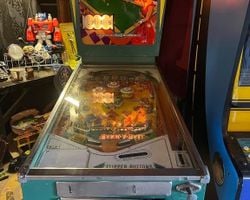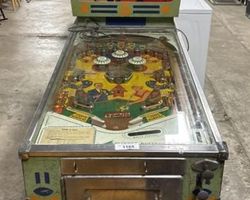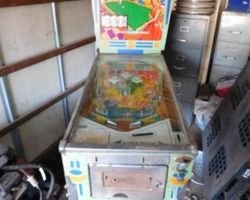Bank-A-Ball

Average Prices: USD $300 to $600
Produced: May, 1950
Production Run: 816 units
Machine Type: Electro-mechanical
Players: 1
Design by: Harry Mabs
Art by: Roy Parker
Bank-A-Ball, a distinctive pinball machine from D. Gottlieb & Co., emerged in May 1950, a period of rapid innovation in the burgeoning pinball industry. With a production run of 816 units, this electro-mechanical (EM) game represented a unique vision, steeped in the familiar world of billiards. Its design and mechanical ingenuity were spearheaded by Harry Mabs, a figure of considerable influence in pinball history, credited with the core design, conceptualization, animation, and mechanical engineering. The vibrant artwork that graced Bank-A-Ball was the creation of Roy Parker, whose illustrative style often brought character and appeal to Gottlieb's machines.
Mabs, a key innovator, had a profound impact on pinball's evolution, particularly in the critical development of the flipper mechanism. Bank-A-Ball stands as a testament to his inventive spirit, capturing the strategic essence of billiards on a pinball playfield. This machine also holds a particular place in history as the last Gottlieb title to incorporate the "turret shooter," a unique plunger mechanism that added a distinct dimension to the game's initiation. An interesting detail, often unnoticed by casual players, is the depiction of Willie Hoppe, an American billiards champion, alongside artist Roy Parker himself, on the lower apron artwork, subtly reinforcing the game’s theme.
Signature Features and Design
Bank-A-Ball distinguishes itself through a design philosophy that prioritizes skillful execution over complex gadgetry. The machine's most notable feature is its "turret shooter," a spring-loaded, rotating mechanism that presents a novel way to plunge the ball into play. Unlike a conventional plunger, the turret shooter requires players to aim the device before launching, adding a layer of initial skill that sets the tone for the entire game. This system, while requiring a brief learning curve for some, offers a satisfying tactile experience and precise control over the initial shot.
Another intriguing element is the "rotokicker," an actuated device that functions akin to a button-activated skill plunge. Positioned strategically, the rotokicker provides players with an additional avenue for control, allowing for nuanced adjustments to ball trajectory immediately after the plunge. This feature contributes to the game’s reputation for demanding precise input from the player from the outset.
The playfield design itself is a signature aspect of Bank-A-Ball. It presents a wide-open canvas, often likened to a billiards table, with minimal central obstructions. The playfield elements are primarily concentrated around the perimeter and in the lower flipper area. This open layout forces players to rely heavily on skillful flipper work and nudging, as opportunities for trapping the ball are rare due to the strategic placement of rubber all around the perimeter and near the flippers. Roy Parker's artwork, described by many as "way sweet," enhances this unique design, portraying the billiards theme with a clean, inviting aesthetic that complements the straightforward yet challenging gameplay. The overall visual appeal, combined with its distinct mechanical features, creates an experience that is immediately recognizable and characteristic of its era.
Playfield and Mechanics
The playfield of Bank-A-Ball is an exercise in elegant simplicity, designed to emulate the open, strategic nature of a billiards table. Unlike later machines that would feature elaborate ramps, multi-level playfields, or an array of distinct toys, Bank-A-Ball’s design emphasizes the raw interaction between ball and flipper on a relatively flat surface. The primary objective is to sink all 15 balls into six designated kick-out holes, strategically placed around the playfield. These holes serve as the main targets, requiring precise aiming and power from the two flippers.
The flow of the game is characterized by its demanding nature. With a scarcity of central playfield features, the ball often travels at speed, bouncing off the perimeter rubbers and presenting continuous, dynamic shots. The design philosophy behind this layout encourages skillful, controlled shots rather than chaotic bouncing. Players must master the angles and power of their flipper presses to guide balls into the kick-out holes, a task made challenging by the lack of readily available ball-trapping zones. The rubber surrounding the playfield perimeter and bordering the flippers ensures that the ball remains in constant motion, putting a premium on quick reflexes and accurate shot placement.
Visually, Roy Parker's artwork on the playfield and backglass reinforces the billiards theme with clarity. The backglass, illuminated by a series of backglass lights, depicts a lively billiards scene that sets the stage for the gameplay. The colors are vibrant, and the lines are clean, creating an inviting aesthetic typical of Gottlieb machines from this period. The artwork on the playfield, while minimalistic, effectively conveys the billiards concept, directing the player’s eye toward the scoring opportunities and kick-out holes. This cohesive aesthetic, combined with the machine’s mechanical precision, ensures that Bank-A-Ball remains an engaging experience despite its age.
Gameplay Dynamics
The gameplay dynamics of Bank-A-Ball revolve around a singular, compelling objective: skillfully guiding all 15 balls into the six kick-out holes scattered across the playfield. This seemingly straightforward goal conceals a surprising depth, demanding consistent accuracy and control from the player. Each ball successfully sunk contributes to the overall progression, building towards the ultimate reward.
The scoring system is primarily focused on this progression. As players successfully deposit balls into the kick-out holes, they work towards lighting "specials." Achieving the full objective of sinking all 15 balls triggers these specials, which typically award credits, extending the game for the player. A particularly satisfying reward is the double knocker, which signifies the achievement of two credits, providing a clear and audible indication of a significant accomplishment.
Bank-A-Ball's unique challenges stem from its wide-open playfield and the prevalence of rubber along its perimeters. Unlike many modern pinball machines that offer numerous targets, ramps, or modes, Bank-A-Ball emphasizes the fundamentals of pinball: precise flipper work and strategic nudging. Controlling the ball is a constant challenge, as trapping opportunities are rare. Players must become adept at live catches, post passes, and bounce passes to maintain control and set up their shots. The game demands a high level of skill to consistently hit the kick-out holes, especially when the ball is traveling at speed. While nudging is a valuable strategy for influencing ball trajectory, some machines may present an over-sensitive tilt mechanism, adding another layer of challenge and requiring players to refine their nudging technique to avoid penalization. The "turret style shooter," while initially requiring adjustment, becomes a tool for a skilled plunge, potentially allowing for strategic initial hits on the lower playfield bumpers. The overall experience is one of continuous, high-energy play, where every shot counts and precision is paramount.
Reception and Legacy
Bank-A-Ball holds a distinguished place in the pinball community, consistently eliciting a positive response from those who have the opportunity to play it. Its primary strength lies in its deceptive depth. While its appearance might initially strike some as elementary or plain due to its wide-open playfield and minimal features compared to later, more ornate designs, players quickly discover a nuanced and challenging experience. Many enthusiasts describe it as highly addictive, highlighting its ability to reward skillful play and precise execution. The core objective of sinking all 15 balls, though difficult, is regarded as immensely satisfying when achieved, contributing to the game's long-term appeal.
The unique playfield design, often compared to a pool table, is considered a stroke of brilliance. It forces players to hone their fundamental pinball skills, emphasizing controlled shots and strategic flipper work over simply activating various playfield mechanisms. The historical significance of Bank-A-Ball is another key strength. As a creation of Harry Mabs, a seminal figure in pinball credited with the flipper's invention, the machine carries a lineage that makes it a revered piece of history. Playing or owning a Mabs-designed game is often seen as a privilege within the collecting community. The rewarding nature of its specials, particularly the double knocker for two credits, adds to the positive gameplay loop.
However, Bank-A-Ball is not without its acknowledged limitations. The most significant is its extreme rarity. With only 816 units produced, finding a Bank-A-Ball in playable condition is a considerable challenge, making it difficult for many enthusiasts to experience firsthand. The initial "plain" aesthetic can also be a deterrent for some casual players, who might overlook its gameplay depth at first glance. Isolated feedback has noted that some machines may feature an over-sensitive tilt mechanism, which can hinder a player's ability to effectively nudge the machine without incurring a penalty. Additionally, the unique turret-style shooter can require a brief period of adjustment for players accustomed to traditional plungers. Despite these minor points, Bank-A-Ball's legacy is firmly cemented as a classic. It stands as an important artifact of early electro-mechanical pinball design, showcasing a period when designers were still exploring the fundamental interactions between player and machine. Its influence lies in its purity of design, demonstrating that a deep, engaging pinball experience does not require an abundance of complex features, but rather a mastery of fundamental gameplay concepts and a challenging, yet rewarding, objective.
Sponsored Links
 Ebay Listings
Ebay Listings
 Auction Results
Auction Results
| Cost | Location | Date |
|---|---|---|
| USD $283 |  Pennsylvania, United States Pennsylvania, United States |
09 October, 2025 |
| CAD $1,000 |  Canada Canada |
15 October, 2023 |
| USD $430 |  Oklahoma, United States Oklahoma, United States |
15 November, 2022 |
| USD $300 |  United States United States |
12 August, 2005 |
| USD $325 |  United States United States |
12 August, 2005 |
| USD $400 |  United States United States |
11 May, 2001 |


Private Policy · Search Website · Contact Us
As an eBay Partner, we may earn a commission from qualifying purchases made through links on this site, at no additional cost to you.
All trademarks and copyrighted materials remain property of their respective owners. All other content copyright 2007 - 2025 Pinpedia.



